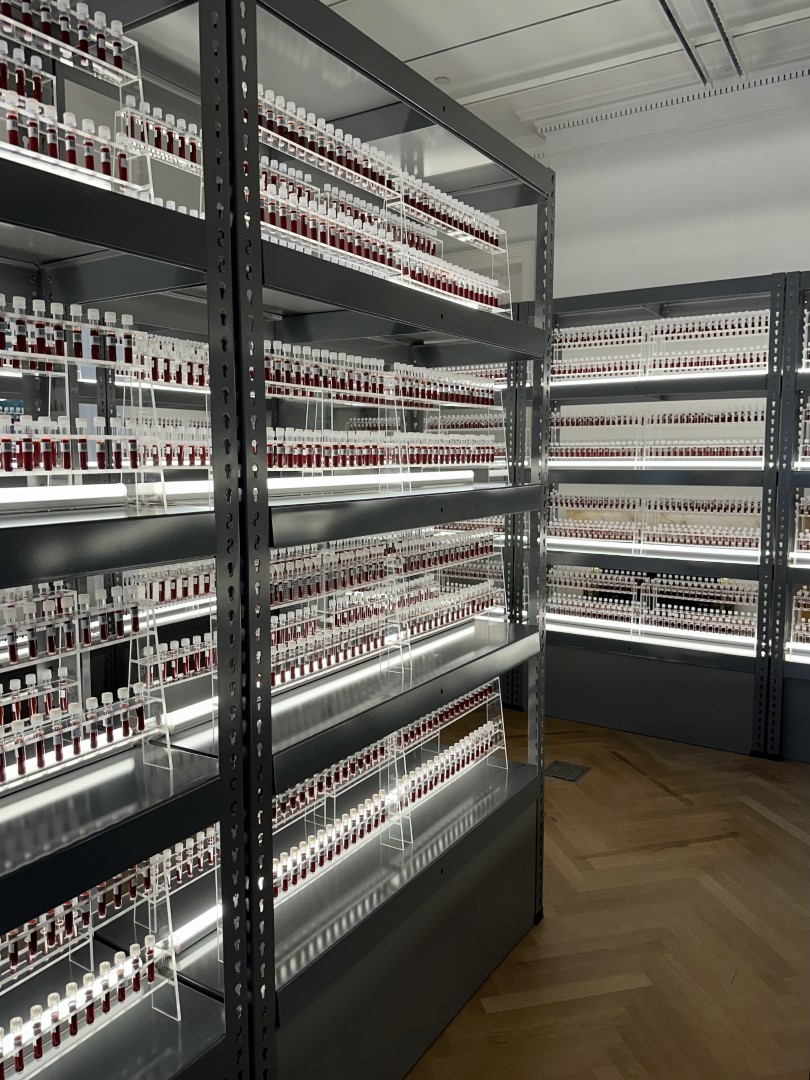IS A BIOBANK A HOME?

ABOUT THE INSTALLATION
HEATHER DEWEY-HAGBORG
BORN 1982, PHILADELPHIA, PENNSYLVANIA; ACTIVE NEW YORK, NEW YORK
Throughout the United States, facilities known as biobanks house the genetic information of millions of citizens. Filled with biological samples routinely collected at hospitals and medical centers, biobanks preserve our medical specimens for public and private research, often conducted with minimal informed consent. Artist and biohacker Heather Dewey-Hagborg considers the hidden homes of our DNA with an installation comprised of three works. Banked explores the architectural and cultural footprint of these spaces while searching for the location of her own biological specimens, beginning with her “blood spot card”—the blood drawn at birth from every newborn to be screened for disorders. Correspondence Song tracks the artist’s exchanges with medical institutions and third parties as she attempts to track down her samples, and Self-Portrait (Pathology) is constructed from specimen slides she obtained when requesting samples of her own bloodwork stored in the medical institution’s biobanks. Dewey-Hagborg’s investigation addresses the potential lives of our DNA at the intersection of surveillance, cutting-edge science, privacy, and legal and ethical concerns.
Visual Description
Is a Biobank a Home? is installed in a gallery with white walls and is brightly lit. The central piece of the installation, titled Banked, is made up of large gray metal shelving units that take up the majority of the space, creating a narrow path to walk down to the end of the room at the left. Each metal unit looks identical with four shelves, all filled with clear glass vials, or more specifically “cryotubes,” with red liquid that reads as blood. On each shelf the vials are held vertically in clear plexiglass stands with two levels on each stand. There are two rows of vials that stand on every shelf. Long fluorescent tube light bulbs are placed in the center of each shelf in between the two rows of vials which illuminate the red liquid. The brightly lit metal shelves, clear stands, and the countless vials create the atmosphere of a biobank. The shelving units are arranged similarly to the shape of a boxy letter G, like a spiraling maze leading to a dead-end. This allows us to walk inside through an opening at the back of the gallery and be surrounded by cold metal and red liquid. In a corner inside the shelving structure, we see large industrial fans that are the same height and metal as the shelves. The narrow structure contains a vent at the bottom and two spinning fans behind vertical barred vent covers, adding to the sense that this is a warehouse facility preserving genetic material. Additional metal fans hang from the ceiling and are pointed down.
As we exit from the center of the shelving units, another work greets us hung from wires, floating in front of the three windows by the back of the gallery. Self-Portrait (Pathology) is a round stained-glass piece approximately two feet wide in a white round frame. The stained glass is primarily clear with a ring of light blue around the border. Thin dark lines connect the curving pieces of glass. Within the large circular piece are a couple dozen small circles a few inches wide and reminiscent of petri dishes or multiplying cells. Inside the smaller circles of stained glass are the artist’s medical slides, like ones that might be put under a microscope. They are rectangular transparent glass with small reddish splotches, each with a sticker containing information with letters, numbers, the artist’s name, dates, and small QR-style codes. Two straight lines divide the work into a cross with four equal sections. Along the outer ring of the small glass circles are several circles without the embedded medical slides. This subtly creates a pattern with the circles that contain the medical slides in the shape of a cross.
Correspondence Song, written by Heather Dewey-Hagborg, tracks the artist’s exchanges with medical institutions and third parties as she attempts to track down her blood samples. This track is audible in the gallery where visitors explore the artists’ installation. Below is the libretto for Correspondence Song:
“Dear Director Bixler,
I was born in Philadelphia at Pennsylvania Hospital in 1982. Would it be possible for me to obtain my records?
Dear Compliance office,
I am a patient in New York. I have read the privacy policy and would like a list of the times my information has been shared in the last six years, whom it has been shared with, and why. My health information may be used for research without my explicit consent.
Dear Privacy office,
I am a patient of Weill Cornell. I have read the privacy policy and become aware that my information may be used. I would like to be informed if it was shared.
I am a patient whose services utilize LabCorp for biological analysis (blood tests, DNA, etc.)
…
Dear Compliance office,
I never received a response…
Dear Privacy office,
I never received a response…
I would like to request an accounting of what research use has been made of my data. I would like to be informed if my information was shared. I would also like to know what third parties have accessed my de-identified data.
…
Dear Ms. Dewey-Hagborg,
Thank you for contacting. Unfortunately, we are not able to provide you with such information.
Dear Ms. Dewey-Hagborg,
This is in response to your Accounting of Disclosures and Accounting of Research requests. Neither New York, nor federal law, nor the statewide health information network require us to account for uses and/or disclosures of de-identified information.
Dear Ms. Dewey-Hagborg,
Thank you for reaching out for an accounting of disclosures. An accounting of disclosures report concluded that there are no accounting of disclosures on file for you.
Please be assured that we value our patients’ privacy.”
Acknowledgements
Special thanks to Fridman Gallery.